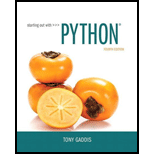
Concept explainers
This term refers to an individual item in a list.
a. element
b. bin
c. cubbyhole
d. slot
The element represents an individual item in a list.
Hence, the correct answer is option “A”.
Explanation of Solution
Element:
- In Python list, the element represents an individual item in a list.
- Every item that is present in a list is termed as an element.
Syntax:
In Python, the elements can expressed as follows:
my_list = [element1, element2, element3,..., elementn]
Explanation:
- The data that are enclosed in the square bracket and comma-separated are called as list elements.
Example program:
#Create a list of different data types
our_list = [101, 102, 103, 104, 'C', 'Alice']
#Print the list
print(our_list)
Incorrect options:
Bin:
Bin is not the term used to refer individual items in a list. It is actually used to store elements.
Hence, option “B” is wrong.
Cubbyhole:
Cubbyhole is not the term used to refer to individual items in a list. Normally, it is a storage structure to hold the elements.
Hence, option “C” is wrong.
Slot:
Slot is not the term used to refer to individual items in a list. Usually, slot is used to store elements.
Hence, option “D” is wrong.
[101, 102, 103, 104, 'C', 'Alice']
In the above Python code, the first line creates a list of various datatypes and assigns them to “our_list”. In the second line, “our_list” is passed as an argument to the method “print()” to display all the elements in “our_list”.
Want to see more full solutions like this?
Chapter 7 Solutions
Starting Out with Python (4th Edition)
Additional Engineering Textbook Solutions
Java: An Introduction to Problem Solving and Programming (8th Edition)
Database Concepts (8th Edition)
Starting Out With Visual Basic (8th Edition)
Computer Science: An Overview (13th Edition) (What's New in Computer Science)
Starting Out with Programming Logic and Design (5th Edition) (What's New in Computer Science)
Concepts Of Programming Languages
 EBK JAVA PROGRAMMINGComputer ScienceISBN:9781337671385Author:FARRELLPublisher:CENGAGE LEARNING - CONSIGNMENTProgramming Logic & Design ComprehensiveComputer ScienceISBN:9781337669405Author:FARRELLPublisher:Cengage
EBK JAVA PROGRAMMINGComputer ScienceISBN:9781337671385Author:FARRELLPublisher:CENGAGE LEARNING - CONSIGNMENTProgramming Logic & Design ComprehensiveComputer ScienceISBN:9781337669405Author:FARRELLPublisher:Cengage C++ Programming: From Problem Analysis to Program...Computer ScienceISBN:9781337102087Author:D. S. MalikPublisher:Cengage Learning
C++ Programming: From Problem Analysis to Program...Computer ScienceISBN:9781337102087Author:D. S. MalikPublisher:Cengage Learning Microsoft Visual C#Computer ScienceISBN:9781337102100Author:Joyce, Farrell.Publisher:Cengage Learning,
Microsoft Visual C#Computer ScienceISBN:9781337102100Author:Joyce, Farrell.Publisher:Cengage Learning, C++ for Engineers and ScientistsComputer ScienceISBN:9781133187844Author:Bronson, Gary J.Publisher:Course Technology Ptr
C++ for Engineers and ScientistsComputer ScienceISBN:9781133187844Author:Bronson, Gary J.Publisher:Course Technology Ptr Systems ArchitectureComputer ScienceISBN:9781305080195Author:Stephen D. BurdPublisher:Cengage Learning
Systems ArchitectureComputer ScienceISBN:9781305080195Author:Stephen D. BurdPublisher:Cengage Learning





